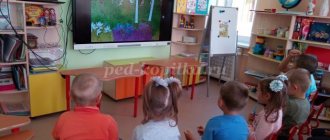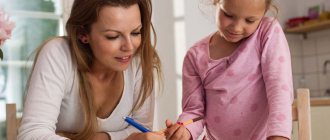Progress of the lesson to study the topic “Utensils”
1. Lesson “Magic bag”
“I have this beautiful bag, and there’s something in it.” Let's see what's inside? Children take turns taking objects out of the bag. Children (3-4 years old) - one object at a time, name it and put it on the table. The older ones try to guess the object by touch, take it out and put it on the table.
2. Conversation
— How can you call all these objects in one word? - Why do we need it? For children (3-4 years old) they name a specific item and ask what we need it for.
3. Lesson “Feed Masha”
— The doll Masha came to visit us. And as is customary, guests must be treated to something. — Let's prepare lunch for our guest. What do we need for this? (Pot, ladle, frying pan) The utensils that we need for cooking are called kitchen utensils. - Let's feed Masha our lunch. What will we take for this? (Deep plate, shallow plate, fork, spoon) The dishes from which we eat are called tableware, and what we use is called cutlery. - Well, after lunch you can give Masha some delicious tea. Take the dishes that we need for this (teapot, saucer, cup, teaspoon). It's called a tea room.
4. Physical school
5. Lesson “What is it stored in?”
Illustrations are posted on the board. Children (5-7 years old) say the answer themselves. An adult helps the younger ones. — Sugar (in a sugar bowl) — Salt — Pepper — Butter — Bread — Sweets — Sauce — Tureen
6. Lesson “What dishes are made of”
An adult places plates (salad bowls) on the table. - How are all these objects similar? (form, purpose) - How are they different? (color, material of manufacture) - Dishes are made from different materials.
Tell me the name of the dishes made from: Glass Wood Porcelain Plastic Metal (Older children name it themselves, younger children with the help of an adult) - If you drop a glass plate, what will happen to it? — If you drop a spoon on the floor, what happens to it?
7. Activity “Collect the fragments”
Children are given pictures of objects cut into several parts. We need to collect pictures. “I wasn’t careful today and broke several objects.” Collect the pictures and find out what was broken.
8. K. Chukovsky “Fedorino’s grief”
- Let’s remember the fairy tale “Fedorino’s grief.” - What happened to Fedora? - Why did the dishes run away from her? — How should you care for plates, forks, and spoons?
9. Summary of the lesson
— Today we talked about dishes, that they are very important and necessary in our lives. We found out that it can be a tea room, a kitchen room, or a dining room. It is made from various materials, so it can be glass, porcelain, wood, or metal. Some materials make it strong, while others make it fragile and can be broken. The dishes must be handled very carefully, washed and put back in their places.
Riddles about dishes for children: 22 best
Website “Mom can do anything!” I have collected the best riddles about dishes for children. Every day we run into the kitchen many times to drink a cup of tea or eat something delicious. Let's try to guess the objects that are hidden behind the “verbal curtain” and live on the shelves of our cozy kitchen.
***
Skilfully jumps in hot pots! With this ladle I can divide food well into deep and shallow plates! (Ladle)
***
I take her by the ear, Although she is obedient and does not cry bitterly, When the tea is hot in her! (Cup)
***
That “boiling artist” is raising a whistle in the kitchen! (Kettle)
***
No problem, quickly, accurately, Bread will be cut into pieces! An object with a thin blade is not more useful at the table! (Knife)
***
My kitten will rub this place with his tongue until it shines, You won’t find any traces of sour cream Neither outside nor inside! (Saucer)
***
She is prickly like a hedgehog And she has a good appetite, There is no better device for eating cutlets! (Fork)
***
Much larger than a mug, With a metal handle, Flies into the well on a chain for some water! (Bucket)
***
When steam streams from the nose, We prepare cups with the whole family, And in an instant, Five saucers for cooking! Who gives us an event called tea party? (Samovar or kettle)
***
They always have the ability to cut paper, fabric and tin! They come in handy - Cutting dough into shapes! (Cooking scissors)
***
A porcelain cup has a stand with a pattern, a beautiful pair in the hands of an antique dealer! (A saucer, and together - a pair of tea)
***
“Plate” for duck With fried breast, Oval often With colorful patterns! (Dish)
***
The tea has a “girlfriend”, a curved ear, which is neat in your fingers. Does it feel good to hold it like this? (Cup)
***
The pan is very deft. I use a slotted spoon! What kind of device is used for boiled dumplings? (A large spoon to remove from boiling water)
***
Table set, Colorful pattern, And on the side of the plates are Hares and squirrels, We often eat from that “dish fairy tale”! (Table service)
***
Not a saber, not an ax, In the kitchen for a long time Everything has been cutting regularly, Stale and fresh! (Knife)
***
Very round in shape, solid edges on the sides, taking that container by the sides, you can drink milk! (Cup)
***
There is a wicker made of birch bark standing on an oilcloth, and there the rye humps lie obediently! (Breadbox)
***
Both small and capacious, With flowers, borders, Forks or spoons frolic in them like cats! (Dishes)
***
What, since ancient times, has been baking pancakes on the “back”, Delicious thin, No thicker than oilcloth? (Pan)
***
What kind of “house” for cabbage soup, for soups, vegetables? That nurse of ours will cook porridge for us in a moment! (Pot)
***
With a well-known name, Dough Roller! (Rolling pin)
***
There is a bowl on a thin stem, There is no more beautiful one on the tablecloth, Going with different wines At the moment of a long conversation! (Wine glass)
Author: Kuzminov V.
Didactic game "Dishes"
Didactic game “Number. Sign. Subject" on the lexical topic "Utensils"
The game is intended for children aged 4-6 years with severe speech impairments, as well as for children of preschool and primary school age to develop the lexical and grammatical structure of speech.
Didactic game “Number. Sign. Subject" can be used both in individual and subgroup lessons with children.
Target:
This set of games will help an adult teach a child:
- agree nouns with numerals and adjectives in gender, number, case;
- select qualitative, relative, possessive adjectives for nouns;
- use ordinal numbers in speech, coordinate them with nouns and adjectives in gender, number, case;
- activate mental activity, associative thinking;
- make comparative sentences with the conjunction “a”.
Material for the game:
cards with game tasks in two subjects of the same lexical group; playing field and cut cards for independent selection and compilation of a plot series; sets of numbers.
Game description:
Game with ready-made models : each table contains tasks for two subjects of the same lexical group for a larger educational load. At the beginning of the game, the child needs to be clearly shown how associations can be used to indicate the characteristics of objects. For example, how can you depict a bitter taste, show the hardness, softness, juiciness of vegetables, color and shape.
Below are ready-made game cards:
- one porcelain deep plate;
- three shiny metal pans;
- two tall shiny glasses;
- five wooden large spoons;
- four sharp metal knives;
- six red plastic bowls;
- one yellow birch bark bread box;
- seven porcelain birch bark cups.
The game requires compliance with the following steps:
- Name a word denoting a number (what number? - four).
- Name the word denoting the object (what is it? - knife).
- Agree the noun with the numeral in gender (how many knives? - four knives).
- Name the words denoting the attribute of an object, coordinate them with numerals and nouns in gender, number (four knives (which ones?) - metal, sharp).
- Agree the numeral with the adjectives and nouns in gender and number. (Say in a complete sentence, starting with the number. – Four sharp metal knives.)
- Using the same principle, consider another object of the lexical group - a bowl.
- Make comparative sentences with the conjunction “a”. (There are four knives, and six bowls. The knife is metal, and the bowl is plastic, etc.)
Game with cut cards : played on the same principle as with ready-made models. Only here the child takes an active position and is given more independence.
First, you should invite the child to choose an item on a lexical topic and place it in a sector with an asterisk, then a number (place in the first sector) and select adjectives in the form of picture symbols (place in the longest sector of the playing field). The symbol pictures are first reviewed and what they mean is explained.
To better understand the progress of the game with cut cards, a sample is provided below.
Using the didactic game “Number. Sign. Subject" children will quickly master the skills of agreeing adjectives, nouns and numerals in gender, number, case; will learn to select adjectives for nouns and develop their associative thinking.
The development of associative thinking has a positive effect on the process of memorizing and reproducing necessary information.
On our website you can find other educational games from the “Number” series. Sign. Item". To do this, follow the highlighted link .
We wish everyone success.






